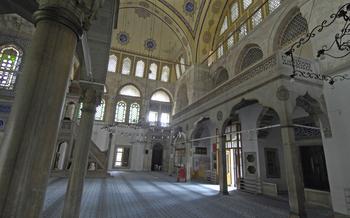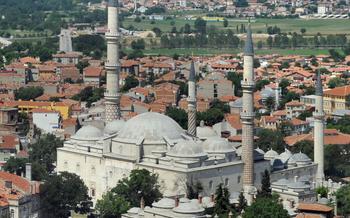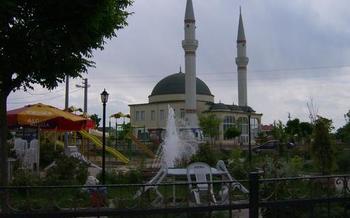
Sultan Selim Mosque
- Sultan Selim Mosque: An Architectural Masterpiece
- Explore the Mosque's Courtyard
- Marvel at the Domed Prayer Hall
- Discover the History of Sultan Selim II
- Learn about the Mosque's Construction
- Immerse Yourself in the Local Culture
- Capture the Beauty of the Mosque
- Dress Code and Etiquette
- Experience the Mosque's Acoustics
- Visit the Mosque During Prayer Times
- Explore the Surrounding Area
- Attend a Religious Ceremony
- Transportation and Accessibility
- Insider Tip: Hidden Gem
Sultan Selim Mosque: An Architectural Masterpiece
With its towering minarets piercing the skyline and intricate tilework adorning its facade, the Sultan Selim Mosque stands as a testament to the architectural prowess of the Ottoman Empire. Built in the 16th century by Sultan Selim II, this magnificent mosque is a symbol of Ottoman power and grandeur. Its awe-inspiring size and opulent decoration reflect the sultan's desire to create a lasting legacy and showcase the empire's wealth and dominance.
The mosque's architectural features are a blend of traditional Ottoman and Byzantine elements. Its massive dome, supported by four massive pillars, dominates the interior space, while the exterior is adorned with intricate carvings and colorful tiles. The interior is equally impressive, with a vast prayer hall illuminated by natural light filtering through the stained-glass windows. The mihrab, or prayer niche, and the minbar, or pulpit, are adorned with intricate tilework and calligraphy, adding to the mosque's overall splendor.
Explore the Mosque's Courtyard
As you step into the courtyard of the Sultan Selim Mosque, a sense of serenity and tranquility envelops you. The expansive space, adorned with meticulously manicured gardens and serene water fountains, invites you to pause and appreciate the beauty of the surroundings. The ablution fountains, with their intricate designs and gentle flow of water, provide a refreshing respite before entering the mosque for prayers.
The courtyard is surrounded by a series of buildings, including the medrese (Islamic school), the imaret (soup kitchen), and the türbe (mausoleum of Sultan Selim II). These structures, with their elegant architecture and historical significance, add to the overall grandeur of the mosque complex. The peaceful atmosphere of the courtyard encourages introspection and reflection, making it an ideal place to connect with your spiritual side.
Marvel at the Domed Prayer Hall
The domed prayer hall of the Sultan Selim Mosque stands as a testament to Ottoman architectural ingenuity. Its colossal dome, soaring high above the faithful, creates a sense of awe and grandeur. The interior of the dome is adorned with intricate tilework, showcasing vibrant hues and geometric patterns that reflect the artistry of the era. The mihrab, a niche indicating the qibla or direction of prayer, is intricately carved and serves as the focal point of the prayer hall. The minbar, or pulpit, from which the imam delivers sermons, is crafted from finely carved wood and adds to the overall elegance of the space. Natural light, filtering through strategically placed windows, illuminates the prayer hall, casting a warm glow upon the ornate decorations. The harmonious blend of architectural elements creates a serene and uplifting atmosphere, inviting worshippers to connect with the divine.
Discover the History of Sultan Selim II
Sultan Selim II, also known as Selim the Sot, was a significant figure in Ottoman history. He ascended to the throne in 1566 and ruled for eight years, leaving a lasting legacy through his contributions to the empire's expansion and development.
During his reign, Sultan Selim II focused on consolidating the vast territories acquired by his father, Suleiman the Magnificent. He expanded the empire's influence in the Mediterranean and the Middle East, leading successful campaigns against the Venetians and the Safavids.
Sultan Selim II was also a patron of the arts and architecture, commissioning numerous grand projects throughout the empire. Among them, the Sultan Selim Mosque stands as a testament to his vision and devotion to Islam. The construction of the mosque reflected his desire to create a magnificent edifice that would symbolize the power and glory of the Ottoman Empire.
Despite his military successes and architectural achievements, Sultan Selim II's reign was marked by internal strife and political instability. His excessive indulgence in alcohol and opium led to a decline in his health and effectiveness as a ruler. As a result, the empire's administration suffered, and the seeds of future challenges were sown during his reign.
Sultan Selim II's legacy remains complex and multifaceted. He is remembered for his military prowess and patronage of the arts, but also for his personal shortcomings and the challenges that arose during his rule. Nevertheless, the Sultan Selim Mosque stands as a lasting tribute to his contributions to the Ottoman Empire, showcasing his vision and the enduring influence of his reign.
Learn about the Mosque's Construction
The Sultan Selim Mosque showcases a remarkable blend of architectural styles, drawing inspiration from both Ottoman and Byzantine traditions. Constructed primarily using stone and brick, its sturdy structure has withstood the test of time. The mosque's intricate tilework, a hallmark of Ottoman architecture, adorns both the interior and exterior, adding to its visual splendor.
The construction of the mosque involved meticulous planning and engineering feats. Skilled artisans employed various techniques, including the use of scaffolding and hoisting mechanisms, to erect the mosque's towering dome and slender minarets. The construction process, which spanned several years, required the collaboration of numerous workers, each contributing their expertise to bring the Sultan Selim Mosque to life.
Despite the challenges posed by the mosque's sheer size and intricate design, its construction proceeded smoothly under the watchful eye of renowned architects and builders. The result is a masterpiece of Islamic architecture that stands as a testament to the ingenuity and craftsmanship of the Ottoman era.
Immerse Yourself in the Local Culture
Visiting the Sultan Selim Mosque offers a unique opportunity to immerse yourself in the local culture and traditions of Edirne. Observe the devout worshippers performing their daily prayers, and engage with the friendly locals who are always eager to share their stories and experiences. Show respect for the local customs and traditions, and embrace the warm hospitality that Turkey is renowned for. Engage in meaningful conversations, learn about the rich history and culture of Edirne, and create lasting memories that will transport you back to this enchanting city long after your visit.
Capture the Beauty of the Mosque
The Sultan Selim Mosque is a visual masterpiece that begs to be captured in photographs. With its towering minarets, intricate tilework, and majestic dome, the mosque offers endless opportunities for stunning shots. To make the most of your photography experience, consider the following tips:
-
Composition: Experiment with different angles to create dynamic and visually appealing compositions. Capture the mosque's grand scale by stepping back and including the surrounding courtyard, or focus on specific details such as the intricate tile patterns or the beautifully carved doorways.
-
Lighting: The best time to photograph the mosque is during the golden hours of sunrise and sunset, when the warm light casts a magical glow on the building's exterior. If you're visiting during the day, try to avoid harsh shadows by shooting in overcast conditions.
-
Etiquette: Remember that the mosque is an active place of worship, so be respectful of worshippers and avoid disrupting their prayers. Ask permission before taking photos of people, and always be mindful of your surroundings.
-
Share Responsibly: Once you've captured your shots, share them responsibly on social media or your travel blog. Include informative captions that provide context about the mosque's history and significance, and tag the mosque's official social media accounts to give them credit.
Dress Code and Etiquette
Sultan Selim Mosque welcomes visitors of all faiths and backgrounds, but it is important to respect the local customs and dress code. Modest clothing that covers the shoulders and knees is expected for both men and women. Women are also required to cover their hair with a headscarf or shawl. Before entering the mosque, visitors must remove their shoes and place them in the designated shoe racks. Once inside, it is important to be mindful of your behavior and remain respectful of the worshippers. Avoid loud conversations, laughter, or any other actions that may disturb the serene atmosphere of the mosque.
Experience the Mosque's Acoustics
The Sultan Selim Mosque is renowned for its exceptional acoustics, creating a unique and awe-inspiring atmosphere within its sacred space. The vast domed prayer hall amplifies even the slightest whisper, allowing the reverberation of prayers and Quranic verses to fill the air. This acoustic phenomenon adds to the spiritual significance of the mosque, enhancing the sense of devotion and tranquility among worshippers. Visitors are often captivated by the echoing sounds that dance through the chamber, creating an immersive and ethereal experience that transcends the boundaries of mere architecture.
Visit the Mosque During Prayer Times
Attending the mosque during prayer times offers a unique opportunity to witness the vibrant atmosphere and spirituality of the place. As the call to prayer reverberates through the air, worshippers gather in the mosque, creating a sense of collective devotion. Observe the rituals and customs associated with the prayers, such as the ablution before prayer, the orderly rows of worshippers, and the rhythmic movements during the prayers. Experience the awe-inspiring acoustics as the prayers and Quranic verses echo throughout the mosque, amplifying the spiritual significance of the experience. Show respect for the worshippers by maintaining silence and avoiding distractions, allowing yourself to be immersed in the sacred ambiance of the mosque.
Explore the Surrounding Area
Beyond the spiritual and architectural wonders of the Sultan Selim Mosque, Edirne offers a wealth of captivating experiences waiting to be discovered. Delve into the city's rich history as you explore its many historic landmarks, including the iconic Selimiye Bridge, a testament to Ottoman engineering prowess. Immerse yourself in the vibrant local markets, where you can haggle for unique souvenirs and savor the delectable flavors of traditional Turkish cuisine. From mouthwatering kebabs to flaky börek and sweet Turkish delight, Edirne's culinary scene is a feast for the senses. Take the time to wander through the charming streets, where you'll encounter friendly locals and discover hidden gems that reveal the city's authentic character. Edirne is a treasure trove of cultural experiences, inviting you to delve deep into the heart of Turkish history, heritage, and hospitality.
Attend a Religious Ceremony
Throughout the year, the Sultan Selim Mosque hosts numerous religious ceremonies and events that offer a glimpse into the rich Islamic traditions of Turkey. One of the most significant events is the Mevlid-i Nebi, or the Prophet's Birthday, which commemorates the birth of Prophet Muhammad. During this special occasion, the mosque is adorned with colorful decorations, and special prayers and recitations are held to honor the Prophet.
During the holy month of Ramadan, the mosque transforms into a center of spiritual devotion. The nightly Tarawih prayers, which are performed during the month, attract large congregations of worshippers who gather to pray and recite the Quran. The mosque's acoustics create a mesmerizing atmosphere during these prayers, with the echoing voices of the worshippers filling the vast prayer hall. The culmination of Ramadan is celebrated with the joyous Eid al-Fitr festival, which marks the end of the fasting period.
If you happen to visit Edirne during one of these special events, make sure to attend a religious ceremony at the Sultan Selim Mosque. It's an opportunity to witness the vibrant Islamic traditions of Turkey and to experience the spiritual and cultural significance of this magnificent mosque.
Transportation and Accessibility
Reaching the Sultan Selim Mosque is a breeze with public transportation. Numerous buses and trams stop nearby, making it easily accessible from various parts of Edirne. For a more convenient option, taxis are readily available and can take you directly to the mosque. If you prefer to drive, there are several parking facilities in the vicinity, ensuring a hassle-free visit.
The mosque is accessible for visitors with disabilities, featuring ramps and elevators that provide easy access to all areas. It is advisable to plan your visit during off-peak hours to avoid the crowds and fully immerse yourself in the tranquility of this architectural gem.
Insider Tip: Hidden Gem
Just a short walk from the Sultan Selim Mosque, you'll find a hidden gem that offers a glimpse into the vibrant local culture: the Ali Pasha Bazaar. This bustling marketplace is a treasure trove of unique souvenirs, traditional Turkish handicrafts, and delectable local delicacies.
As you wander through the labyrinthine streets of the bazaar, you'll be captivated by the vibrant colors, enticing aromas, and friendly banter of the vendors. Here, you can haggle for one-of-a-kind souvenirs, such as intricately woven carpets, hand-painted ceramics, and gleaming copperware.
Indulge your taste buds with Turkish delights, from melt-in-your-mouth baklava to aromatic Turkish coffee. Savor the flavors of freshly baked simit (sesame-encrusted bread) or tantalize your palate with a variety of olives, cheeses, and spices.
The Ali Pasha Bazaar is not just a place for shopping; it's a vibrant hub where locals and tourists alike come together to socialize, share stories, and experience the authentic Turkish culture. Take your time to explore this hidden gem and immerse yourself in the lively atmosphere of this bustling marketplace.









